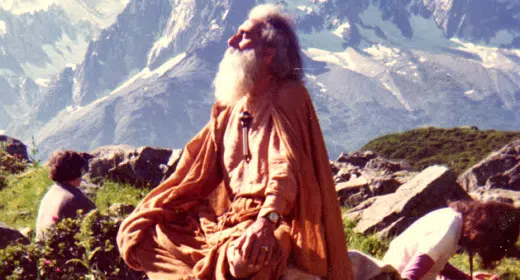The ever-restless John Bennet scanned the horizon after Gurdjieff’s death in 1949 and independently arrived at certain conclusions while the Paris group settled in to establish its franchise.  Without reaching too far, he deduced that Gurdjieff, in his book, “Meetings with Remarkable Men” had transliterated Bahauddin Naqshband, as Bogga Edin, the Bohkoran Dervish. Armed with this clue, he set out to find the head of the Naqshbandi Order, and eventually met Grand Shaykh Abd Allah ad-Daghestani. This contact has since opened a flow of people between these two traditions. For this, and other reasons, many Gurdjieff followers have since taken a long hard look at the Naqshbandi Order. Bennet traced the careers of several Khwajagan Masters, who were also Naqshbandi leaders. One such Grand Shaykh, Khwaja Abdul Khaliq al-Gujdawani, the eleventh link in the chain of the Naqshbandi succession, used eight phrases to describe how to gain consciousness. Mawlana Shaykh Hisham Kabbani has included these and much fuller explanations in his book, The Naqshbandi Sufi Way – History and Guidebook of the Saints of the Golden Chain.” Briefly, they compare to the Work equivalents as follows:
Without reaching too far, he deduced that Gurdjieff, in his book, “Meetings with Remarkable Men” had transliterated Bahauddin Naqshband, as Bogga Edin, the Bohkoran Dervish. Armed with this clue, he set out to find the head of the Naqshbandi Order, and eventually met Grand Shaykh Abd Allah ad-Daghestani. This contact has since opened a flow of people between these two traditions. For this, and other reasons, many Gurdjieff followers have since taken a long hard look at the Naqshbandi Order. Bennet traced the careers of several Khwajagan Masters, who were also Naqshbandi leaders. One such Grand Shaykh, Khwaja Abdul Khaliq al-Gujdawani, the eleventh link in the chain of the Naqshbandi succession, used eight phrases to describe how to gain consciousness. Mawlana Shaykh Hisham Kabbani has included these and much fuller explanations in his book, The Naqshbandi Sufi Way – History and Guidebook of the Saints of the Golden Chain.” Briefly, they compare to the Work equivalents as follows:
1. “Conscious Breathing”
Each breath taken with heedlessness is dead, and each breath taken with worship and presence is alive and connected with the divine presence. While this is devotional in tone, the relevance to both traditions is self-evident.
2.”Watch Your Step”
Lower your gaze to your feet. This will screen out many distracting and disturbing images throughout the day, and is also a sign of humility. From the Gurdjieff aspect, the practice could help prevent many of the more destructive “identifications” that seize us at each moment creating ever widening ripples of associations and daydreams. This exercise sounds deceptively simple. Just try it!
3. “Journey Homeward”
The journey from the world of creation to the world of the creator is made in two stages: first, the external journey is to locate a true guide; and second, the inward journey is to cleanse the heart while enjoying the guidance. Phrased in terms of the Work, find your teacher and begin the task raising your level of being and cleaning your machine.
4. “Solitude in the Crowd”
There are two kinds of seclusion: external and internal. The external requires solitude for set periods of time in order the carry out specific exercises. The internal seclusion means to be outwardly with people, but inwardly with God. The Naqshbandi Way includes both, but typically emphasizes the second. Gurdjieff followers widely quote the related Sufi ideal, “Be in the world, but not of it!’
5. “Essential Remembrance”
This practice is rather like some of the “sensing” exercises prescribed in the Gurdjieff Work. The phrase, “la ilaha ill-Allah,” (there is no God, but God, is repeated many times. With each word of the phrase, the chanter “says” each word from a different part of his body in a particular order.
6. “Returning”
This is the practice of remembrance of Allah (dhikr) with the aim of achieving unity. An invocation to instill an awareness of the oneness of God is a key element of mysticism in general – to a Gurdjieff follower, alerted to the fatally fragmented state of his own being, the search for unity takes on a special importance.
7. “Attentiveness”
This is the practice of safeguarding the heart from bad inclinations. Such vigilance, maintained continuously for even fifteen minutes, is considered a great achievement. For Gurdjieff pupils who have struggled with the exercise of not expressing negative emotions, the difficulty of blocking them nearer to their source can be readily appreciated.
8. “Recollection”
This term corresponds to the actual accomplishment of raising the heart into the divine presence. It marks the point of liberation from egoistic, evil and imaginary thoughts. With this sustained act, reality, unity and truth are fully embraced. This seems to echo some of the stations attributed to the higher numbers of men described in the Gurdjieff teaching and their accompanying degrees of permanence.
These techniques of the Twelfth Century Naqshbandi master underscore the enormity of the quest to acquire consciousness. While the Gurdjieff pupil can appreciate the range and depth of these principles, there may be a certain lingering puzzlement over the religious cast of the techniques. This is, to say the least, a pivotal point in these comparisons. The Sufi journey to consciousness always brings the Creator into the equation. However, upon closer inspection, the introduction of this element may not be as foreign to the Gurdjieff outlook as it at first seems. Consider, for a moment, the diagrams on awareness that Rodney Collins included in his book, “The Theory of Celestial Influence.” At his teacher’s request, this student and protégé of Ouspensky took on the task of linking the Work ideas to various branches of modern science. The results were impressive, and no one since has attempted as disciplined a comparison as his.
In three simple diagrams, Collin builds the elements of self remembering, and explores the relationships between them. His diagram is shown in three stages. First, someone beholds a tree in the state of fascination.
 The arrow points one way, because the energy of attention is only flowing only outward. The beholder is reduced to a dot – he has forgotten himself. This is the ordinary state of our awareness, a fatal and characteristic mindless absorption in the things surrounding us. His second diagram depicts the division of attention.
The arrow points one way, because the energy of attention is only flowing only outward. The beholder is reduced to a dot – he has forgotten himself. This is the ordinary state of our awareness, a fatal and characteristic mindless absorption in the things surrounding us. His second diagram depicts the division of attention.

Here the beholder sees both the tree and himself looking at the tree. He has divided his attention and directs some of his awareness back upon himself. However, this is still not self remembering, because the occurrence of consciousness is a real phenomenon, and by definition, in the Gurdjieff system a phenomenon must manifest the Law of Three, – it must bring a third force into play. The third diagram depicts this third enveloping force and its position in the flow.
 |
|||
|
Here the beholder divides his attention, but also opens his awareness to a higher force, which embraces and enables the entire act of seeing. Collins points out that this third force could be the his school, his teacher, the Sun, some higher power in the universe, or God. Self remembering must be done at the moment of cognition. It is partially an act of seizing that moment and making it one’s own, and it is also an act of re-membering, in the sense of reconstructing an awareness over a series of moments, which in our usual state, would be dismembered.
How many long-time Gurdjieff students have trained with the intensity of decathlon athletes to raise their levels of self awareness just so far, only to reach the inevitable “training plateau?” For many, a programmatic and sustained invocation of the divine creator, a central ritual of all ages, has reportedly provided that transcendent element to push beyond the envelope of “self.” In any event, the idea is not inconsistent with the concept of Law of Three in its application to the completed “event” of self remembering.
Self remembering, therefore, involves some sort of overarching awareness and a spark strong enough to light it. Anyone reading between the lines will recognize in Ouspensky’s writings the passion of his search, belying his usual image as a dry intellectual. With crystalline logic he wove the best description of Gurdjieff’s system to date, repeatedly asserting that at some point the emotional energies must be brought to bear on the Work ideas. Impressive as they are in their own right, these ideas were somehow meant to be indelibly imprinted on the beholder. Ouspensky pursued an ordered approach to Gurdjieff’s teaching with a sustained desire for truth, and this is what inspired his cool headed reckoning of time and space in and about his master’s intricate cosmology. For Sufi’s, a resolute focus on the unity and reality of the Creator of All actually supplies this movement. Significantly, the Naqshbandis specialize in the “Naqsh,” or the seal, which is engraved on the heart after it has been sufficiently polished. Their formal prayers of remembrance, or Dhikrs, lead off with a chant known as the Seal of the Khwajagan.
Each of these systems presents different strengths. Gurdjieff sometimes characterized his as a mission to blend the wisdom of the East with the knowledge of the West. It was an heroic and highly experimental proposition from the start. It has brought very powerful ideas to thousands of Westerners who would never have encountered them otherwise. The Sufis are part of the East and are operating on home ground in their wisdom traditions. The various Sufi orders all have recorded accounts of saints and mystics who have reached high stations and lived out lives of a distinctly different nature from the rest of us. Gurdjieff postulated higher orders of man, numbered up to seven in his scheme denoting degrees of development. Gurdjieff said that only stations counted, not states. Both traditions seem to stress that the paths to these stations lead through a place of fusion, where certain inner qualities are fixed or reconnected in some way to form and reform our central natures. Self remembering and remembrance light the way on each path.












































